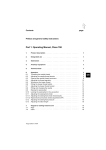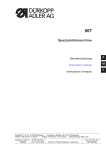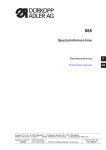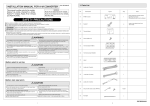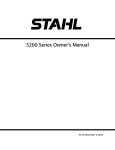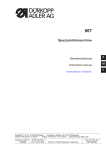Download Duerkopp Adler 577-1111 Operating instructions
Transcript
Home Contents Page: Preface and General Safety Standards Part 1: Operating Instructions cl. 577-1111 1. Product description . . . . . . . . . . . . . . . . . . . . . . . . . . . . . . . . . . . . . . . . . . . 5 2. Normal use 3. Technical data 4. 4.1 4.2 4.3 4.4 4.5 4.6 4.7 4.8 4.9 4.10 Operation Threading the needle . . . . . . . . . Winding the hook thread . . . . . . . Inserting the bobbin . . . . . . . . . . Changing the needle . . . . . . . . . Lifting the sewing cage . . . . . . . . Regulating the sewing cage pressure Setting the buttonhole length . . . . . Setting the number of stitches . . . . Changing and adjusting the knife . . Thread tension . . . . . . . . . . . . . 5. 5.1 5.2 5.3 Control and control panel General . . . . . . . . . . . . . . . . . . . . . . . . . . . . . . . . . . . . . . . . . . . . . . . . . . . 17 Keys on the control panel . . . . . . . . . . . . . . . . . . . . . . . . . . . . . . . . . . . . . . . . . 18 Changing parameter values . . . . . . . . . . . . . . . . . . . . . . . . . . . . . . . . . . . . . . . 19 6. 6.1 6.2 6.3 Sewing Normal sewing cycle . . . . . . . . . . . . . . . . . . . . . . . . . . . . . . . . . . . . . . . . . . . 22 Interruption of th4e sewing cycle . . . . . . . . . . . . . . . . . . . . . . . . . . . . . . . . . . . . . 22 Monitoring the hook thread by counting the buttonholes . . . . . . . . . . . . . . . . . . . . . . . . 23 7. 7.1 7.2 Maintenance Cleaning and checking . . . . . . . . . . . . . . . . . . . . . . . . . . . . . . . . . . . . . . . . . . 24 Lubrication . . . . . . . . . . . . . . . . . . . . . . . . . . . . . . . . . . . . . . . . . . . . . . . . . 25 8. Auxiliary equipment . . . . . . . . . . . . . . . . . . . . . . . . . . . . . . . . . . . . . . . . . . . 26 . . . . . . . . . . . . . . . . . . . . . . . . . . . . . . . . . . . . . . . . . . . . . . . . 5 . . . . . . . . . . . . . . . . . . . . . . . . . . . . . . . . . . . . . . . . . . . . . . 6 . . . . . . . . . . . . . . . . . . . . . . . . . . . . . . . . . . . . . . . . . . . . . . . . . . . . . . . . . . . . . . . . . . . . . . . . . . . . . . . . . . . . . . . . . . . . . . . . . . . . . . . . . . . . . . . . . . . . . . . . . . . . . . . . . . . . . . . . . . . . . . . . . . . . . . . . . . . . . . . . . . . . . . . . . . . . . . . . . . . . . . . . . . . . . . . . . . . . . . . . . . . . . . . . . . . . . . . . . . . . . . . . . . . . . . . . . . . . . . . . . . . . . . . . . . . . . . . . . . . . . . . . . . . . . . . . . . . . . . . . . . . . . . . . . . . . . . . . . . . . . . . . . . . . . . . . . . . . . . . . . . . . . . . . . . . 7 . 8 . 8 . 10 . 11 . 11 . 12 . 13 . 14 . 16 3 Stand set for longitudinal installation Stand set for transversal installation Stand set for transversal/longitudinal operation 4 1. Product description The DÜRKOPP ADLER 577-1111 is an automatic double lockstitch machine with bottom and top feed for sewing buttonholes with two straight bars. Normal sewing mode: During the sewing process the fabric face ( the face seen) ) is up. The machine can be supplied in three installation variants ( see on the left ). 2. Normal use The automatic sewing machine DÜRKOPP ADLER 577-1111 has been designed for sewing light to middle-heavy weight material, as used in the apparel industry. Such material consists generally of textile or synthetic fibres. Furthermore, the machine lends itself for producing so-called technical seams. In this case, the user must estimate any possible dangers (contact dürkopp adler ag for help), Technical seams are seldom, but they may be very versatile. Proper safety precautions, depending on the result of such an estimation, must be taken. Generally, only dry material should be sewn on this machine. And the material should not exceeded the thickness of 4 mm when compressed by the lowered sewing foot. The material should not contain any hard objects, because otherwise it would be necessary to protect the eyes during the sewing process.. For the time being, no such eye guard is available. The seams are produced generally with threads up to 65/2 Nm ( cotton-covered synthetic threads or synthetic threads ) Before using any other threads it is necessary, also in this case, to estimate the consequential dangers and to take, if necessary, the respective safety measures. This automatic sewing unit should be installed and operated only in dry and proper rooms. Otherwise, further precautions (to convene) may be needed, ( siehe EN 60204-3-1:1990 ). We.manufacturers of industrial sewing machines, assume, that our machines will be operated at least by a well trained staff, knowing all usual controls and any possible dangers. 5 3. Technical data Machine heads: Class 577-1111 Needle system: Needle thickness: Threads: System 265, needle point slightly rounded off 70 - 100, Standard 80 Synthetic threads, and cotton-coated synthetic threads Stitch type: Speed: Up to 65/2 Nm Double lockstitch up to. 4000 rpm ( adjustable ) Number of stitches Per seam pattern: 76 - 510 Buttonhole length: Buttonhole width: 10 - 48 mm 0 - 6 mm Cut length: max. 38 mm Motor type: Nominal performance: Speed: EFKA DC1600/DA82GL 0,75 kW 4000 U/min Service pressure: 6 bar Air consumption: about 4 NL per working cycle Nominal voltage: 1 ~ 230 V, 50/60 Hz 1~ 190 - 240 V, 50/60 Hz Dimensions: Longitudinal stand: 1060 x 620 x 1250 mm ( L x B x H ) Longitudinal/transversal stand: 800 x 650 x 1250 mm ( L x B x H ) (Machine head without stand: 180 x 600 x 450) 6 Working level: Weight: 750...895 mm ( Table top ) ca. 135 kg ( with stand ) Rated noise level: Lc = .... dB (A) 4. Operation 4.1 Threading the needle CAUTION: DANGER OF ACCIDENTS ! Turn off main switch! Switch off the machine before threading the needle. – Thread then needle according to the illustration. 7 4.2 Winding the hook thread 3 1 2 – – – – – – – – 4.3 Slip the reel onto its stand. Thread the hook according to the illustration. Slip the bobbin onto the bobbin winder 1 . Wind the hook thread clockwise about 5 times around the bobbin core. Swing bobbin winder lever 2 towards the bobbin and let it snap. The thread will be wound during the sewing process. The bobbin winder lever 2 will stop the winding process as soon as the bobbin is full. Following the winding process, tear off the bobbin thread at the thread clamp 3. Inserting the bobbin CAUTION: DANGER OF ACCIDENTS ! Turn off main switch! Switch off the machine before changing the bobbin! Removing empty bobbin. – Open hook space cover 4. – Lift the bow 5 and remove bobbin case top together with the bobbin. – Remove the empty bobbin from the bobbin case top. 8 5 4 Threading the bobbin – Insert the full bobbin into the bobbin case top. When unwinding the thread, the bobbin must turn clockwise. – Pass the hook thread through the slit 6 and under the spring 7. – Depending on the buttonhole to be sewn, pass the hook thread through the slit 9 for a raised buttonhole ( more thread will be advanced across the hook back) ) or through the slit 10 for a flat buttonhole ( less thread ). – Cut then the thread, passed as described, by the knife 11. Adjusting the hook thread tension – Adjust the hook thread tension by turning the screw 12 so that, when holding the thread at its end, the bobbin case descends by its own weight. 11 6 9 10 12 7 Inserting the bobbin case top – Place the bobbin case top together with the bobbin onto the bobbin case bottom and ensure that the bow 5 snaps (what you should hear). – Close the bobbin space cover 4. 9 4.4 Changing the needle CAUTION: DANGER OF ACCIDENTS ! Turn off main switch! Switch off the machine before changing the needle! 1 Knife side – – – – – Loosen the screw 1. Remove the neelde from its bar. Introduce the new needle as deep as possible into its bar a. Adjust the needle so that its furrow is located on the other side of the knife. Tighten the screw 1. NOTE ! The factory-set distance between the hook and the needle applies to the needles having a thickness of 80. When inserting a needle having a different thickness it may be necessary to correct the distance ( see the Service Instructions ). 10 4.5 Lifting the sewing cage The sewing cage 2 will be lifted only if the main switch is turned on and if following conditions exist: – Sewing cage in initial position ( rear p. ) – Thread take-up lever in top dead-center position ( needle in upper position ) If the thread take-up lever does not stand in its top dead-center position ( error message in the display of the control panel: "_0 1 0" ), the machine will automatically turn into this position after turning on the main switch. After turning on the main switch, following message will be presented on the display of the control panel: "_0 1". if the sewing cage does not stand in its initial position Turn then the crank until the sewing cage stands in the proper position and can be lifted. By treading the pedal forwards into its 1 st position, the sewing cage will be lowered without starting the sewing process. The sewing cage can be lifted and lowered by the key 3 on the control panel. Then it is necessary to switch on the parameter "F - 020" on the operator level ( see chapter 4.9 ). 3 2 4.6 Regulating the sewing cage pressure – The sewing cage pressure can be regulated by the screw 3. 11 4.7 Setting the buttonhole length CAUTION: DANGER OF ACCIDENTS ! Turn off main switch! Turn off the machine before changing the buttonhole length! 2 1 – – – – – – – Remove the crank 1. Open the cover 2 completely. Loosen the screw 3. Reset the lever 4 in the crank. Tighten the screw 3. Release the support 5 and close the cover 2. Install the crank 1. 5 3 4 12 4.8 Setting the number of stitches CAUTION: DANGER OF ACCIDENTS ! Turn off main switch! Switch of the machine before changing the number of stitches! – – – – – Remove the crank. Open the cover 2.completely Change the gears 6 in pairs according to the table. Release the support 5 and close the cover. Install the crank. 5 2 6 Number of stitches 76 81 86 91 97 102 108 114 120 127 134 141 149 157 165 173 182 192 Number of teeth at top/at bottom 22 / 57 23 / 56 24 / 55 25 / 54 26 / 53 27 / 52 28 / 51 29 / 50 30 / 49 31 / 48 32 / 47 33 / 46 34 / 45 35 / 44 36 / 43 37 / 42 38 / 41 39 / 40 Number of stitches 202 212 223 235 247 261 274 289 305 321 339 358 379 401 425 451 479 510 Number of teeth at top / at bottom 40 / 39 41 / 38 42 / 37 43 / 36 44 / 35 45 / 34 46 / 33 47 / 32 48 / 31 49 / 30 50 / 29 51 / 28 52 / 27 53 / 26 54 / 25 55 / 24 56 / 23 57 / 22 13 4.9 Changing and adjusting the knife CAUTION: DANGER OF ACCIDENTS ! Turn off main switch! The sewing cage must stand in its initial position, because otherwise the knife will knock against the cage! Switch on the adjustment aid before installing the knife! 3 1 2 Remove the knife – Loosen the nut 1. – Pull out the knife 2. Install the knife Switch on the adjustment aid, and: – Turn on the main switch. ( the cage will be lifted. ) – Press the key "P" on the control panel. ( The menu of the operator level will be called up. ) – Cross the menu by operating the key until "+" "F - 020" is displayed. – "oFF" will appear after pressing the key "E". – Press the key "+" for switching on the adjustment aid. ( The display will present "on" and an arrow above the key 3. ) NOTE ! Do not turn the handwheel or the crank when using the adjustment aid! 14 – Insert new knife ( loosen nut 1 ) and push it first up to the top. NOTE ! It is absolutely necessary to note that the distance between the upper thread scissors and the knife bottom amounts to at least. 1 mm. – – Tighten the nut 1. Lower the sewing cage by pressing the key Taste 3. – With the adjustment aid still being engaged, it is now possible to lower the knife block by operating the key 4. ( An arrow will appear above the key 4. ) – Operate the key 4 once again for lifting the knife block. The knife block cannot be moved down by the key 4 as long as the sewing cage is not lowered. Therefore, first lower the sewing cage by the key 3. Also the function of the key 3 (lifting the sewing cage) is locked as long as the knife is in its lower position. It will be impossible to start the machine as long as the adjustment aid is engaged. Adjusting the knife When the knife block is lowered, the front edge of the knife should stand about. 2 mm under the bottom of the throat plate. Adjustment: – Lift the sewing cage. – Loosen slightly the nut 1. – Displace the knife. – Tighten the nut 1. – Check the cutting depth and repeat the process, if required. The cut of the knife should be about 2 tissue threads from the last sewn final bartack. Adjustment: – Loosen the screw 3 and adjust the distance accordingly. Note: When the knife block is in its lowered position, the safety distance between the front edge of the knife and the slit in the throat plate insert must amount to 0,5 mm. – Tighten the screw 3. End the adjustment aid For ending the adjustment aid press the key "P" on the control panel. 15 4.10 Thread tension The machine head has been set in the factory for sewing buttonholes with flat bartacks and with raised lips. 4 5 6 Pre-tension The pre-tension 4 is always active. It serves for stabilising the needle thread. It should be set to the minimum value ( 5-10 g ). The pre-tension 4 has scarcely any influence on the seam pattern. Main tension The main tension 5 is active when sewing both buttonhole lips. But the main tension 5 it is out of action when bartacking and when cutting the threads. Bartack tension The bartack tension 6 is opened only when cutting the threads. It is remains closed during the entire remaining sewing process. Buttonhole lip tension The buttonhole lip tension is produced jointly by the main tension 5 and by the bartacking tension 6. About 1/3 of the buttonhole lip tension should be produced by the bartacking tension 6. Adjustment – Thread the needle thread so that it does not pass through the main tension 5. – Start the sewing process. 16 – Adjust the bartacking tension 6 so that the maximum possible quantity of the thread unwound is consumed during the sewing process. But ensure that the thread does not flatter above the pre-tension and that it is not torn. – Thread the needle according to the chapter 4.1. – Start the sewing process according to the chapter 6. – Adjust the main tension 5 so that a satisfactory seam pattern is obtained when sewing the buttonhole lips ( regularly raised lips ). If the seam quality is worse after a thread change, proceed to a correction. Turn only the main tension 5. Control – Use threads of different colours for threading the needle and the hook. – Carry out a sewing test. When using two-colour threads, the colour of the needle thread in the bartacks should be visible only from above. 5. Control unit and control panel The present Manual describes only the function of the keys and the change of parameters by the operator. For a detailed description of the control unit see the attached actual Operating Instructions of the motor manufacturer. 5.1 General The control panel is used for programming the control unit and for setting the respective seam functions. This is done partly directly by operating the respective keys or by changing the parameters. The parameters are entered in the programming mode. The parameters and the assigned values are presented by the display.. In order to avoid any involuntary chages of the pre-set parameters, the attendance of the control panel is subdivided into different levels ( operator, technician, fitter ). The operator has a direct access to its level. For having an access to the other levels it is necessary to enter a code number or it is necessary to press several keys simultaneously. NOTE ! Do not turn the handwheel or the crank during the parameter change on the operator level! Reset When the control unit is totally out of adjustment, the technician can, by means of a Reset Function, reset all adjustment values to the state existing at the moment of delivery. The Reset Function is described in the Service Instructions. 17 1 5.2 3 4 A B Keys on the control panel Function Key 18 2 Adjustments P Call up/end programming mode E ( Only in the programming mode ) Displaying the parameter value / Rendering the parameter value for a change Quitting a parameter entry with a simultaneous change to the next parameter + Direct function: Increase the speed In programming mode: Change to the next parameter of the parameter list Increase the displayed parameter value / Switch on the displayed parameter ( "on" ) - Direct function: Reduce the speed In the programming mode: Return to the previous parameter of the parameter list Reduce the displayed parameter value / Switch off the displayed parameter ( "oFF" ) Key 1 Soft start on / oFF Key 2 Double cycle on / oFF Key 3 Only when the Programming mode and "F - 020" are set to "on" lifting/lowering the sewing cage Key 4 Only when the Programming mode and "F - 020" are set to "on" connect/disconect the knife Key A ( without function ) Key B Direct function: Only when the parameter adjustment "F - 195" corresponds to "4" Short operation: Reset the hook thread counter ( after bobbin change ) Operation time longer than 1 second: Connect/disconnect the hook thread counter Programming mode: Shift key ( see the Operating Instructions of the motor manufacturer ) ( Key B ) 5.3 Adjustments Function Key on / oFF Changing parameter values NOTE ! It is absolutely necessary to complete a sewing cycle after the parameter change. It is only then that the modified adjustment will be definitely memorised. If no sewing is done, the new setting will be lost by turning off the main switch! For changing or switching on and off the parameters press the keys "P", "E", "+" and "-" on the control panel. The parameters that can be changed on the operator level are stated in the following parameter list. Calling up programming mode – Operate the key "P". The parameter, called up as last one, will appear.. If no parameter has yet been called up after turning on the main switch, the display will present "F - 000". Selecting the desired parameter – Operate the key "+" or the key "-".until the desired parameter is displayed – The parameter value will be displayed after pressing the key "E". Changing the displayed parameter – For changing the parameter value or for switching on or off the parameter function press the keys "+" or "-". Memorising the modified parameter value – Press the key "E" for changing further parameter values. The modified parameter value will be memorised. The display will present the next parameter on the operator level. or: – Press the key "P" in order to quit the programming mode. The parameter value, modified as last one, will be memorised. The control system will quit the programming mode. 19 Parameter list on the operator level Parameter Denomination max Adjustment min Standard F - 000 Buttonhole counting On/Off (This function is only possible when the machine speed display, Parameter "F - 139", is switched off ) on oFF oFF F - 001 Reset buttonhole counting on oFF oFF F - 020 Adjustment aid for the knife and for the thread cutter, connected mechanically with the sewing cage. The following functions are enabled only when the needle stands in its upper position and the sewing cage in its rear position . on oFF oFF Key "+" on Key 3 right arrow On Sewing cage in upper position Key 3 right arrow Off Sewing cage in lower position Key 4 right arrow On Knife On Key 4 right arrow Off Knife Off Only one function at a time can be controlled! 20 F - 080 Correction ( + ) of the after-running stitches at the buttonhole end 10 0 0 F - 081 Correction ( - ) of the after-running stitches at the buttonhole end 10 0 0 F - 085 Number of buttonholes for the hook thread monitor "F - 195" to "1...4" 3000 0 0 State Display Display Denomination InF P1 Error in the determination of the after-running stitches. The number of the after-running stitches is too low. InF P2 Error in the determination of the after-running stitches. The number of the after-running stitches is too high. The machine runs The hook thread monitor can be switched on. ( only when the parameter "F - 195" is set to "4" ) blinking symbol: The counting for the hook thread monitor has commenced. Blinking symbol and display of "C D": The counting has ended, change the bobbin! The display of the control panel will present up to 4 different inadmissible conditions resulting from a number combination. A _1 1 1 1 Sewing cage not in its initial position (rear pos) Thread take-up lever not in its top dead centre position. (needle not in upper pos.) Needle thread monitor acting Instant stop has been released ( stop ) A combination of several inadmissible conditions is possible, e.g.: A _0101 Needle thread monitor active / Sewing cage not in rear position Display of the sewn buttonholes.: B 12345 max. 65535 The counting for the hook thread monitor has ended.: CD 12345 21 6. Sewing NOTE ! Do not start sewing with the machine before is has been fully assembled and before, among others, all the protective devices has been installed.! 6.1 Normal sewing process Start the sewing process – Turn on the main switch. – If the sewing cage is not lifted, turn the crank until the sewing cage stands in its rear position ( initial position ). The sewing cage will be lifted. – Insert the material to be sewn. – Start the sewing process by treading the pedal forwards ( the sewing cage will be lowered, the buttonhole will be sewn, the knife will act, the threads will be cut off and the sewing cage will be lifted ) – For being able to start a new sewing process, Before the end of the sewing process, the pedal must be returned to its neutral position, in order to enable the start of the next sewing cycle. 6.2 Interruption of the sewing cycle The sewing cycle can be interrupted as follows: Interruption by the operator – By treading the pedal backwards, the sewing process will be interrupted within the buttonhole. – The error message "_1 0 " will be displayed. – Turn off main switch and eliminate the cause for the interruption. Interruption by thread breakage – The error message "_0 1 0 " will be displayed. – The sewing cage will be moved, without needle thread, up to the buttonhole end, the knife and the thread cutter will not act and the sewing cage will not be lifted. – Thread the needle according to chapter 4.1. Following is to be noted after an interruption – If the sewing cage stands in its initial position ( rear position ), it can be lifted by treading the pedal backwards. – If the commenced buttonhole is to be completed by a repair seam, the sewing cage should not stand in its initial position (rear position) when the main switch is turned on again, because otherwise it will be lifted. Before turning on the main switch, take the sewing cage to the repair point by turning the crank. – If the repair point lies within the second half of the second buttonhole lip (short before the buttonhole end), a complete buttonhole will be sewn as a repair seam. 22 Go on sewing After an interruption, there are three possibilities to continue the sewing process: – Continue the sewing process out of the actual position by treading the pedal forwards or BLICKFANG-STR = Take the sewing cage to the desired point by turning the crank and restart the sewing process here or – take the sewing cage to its initial position (rear position)by turning the crank and lift the cage for removing the material. 6.3 Monitoring the hook thread by counting the buttonholes When the parameter "F - 195" has been set to the value "4" ( technician level, see the Service Instructions ), the bobbin symbol will appear on the right side of the display The operator can, by maintaining this position and by using the parameter "F - 085" enter the number of buttonholes ( 1 - 3000 ) that, according to the experience, can be sewn with one hook thread bobbin ( see chapter 5.3 ). For starting the buttonhole counting, press the key B, longer than 1 second: – The bobbin symbol will be blinking during the sewing process. – After the number of buttonholes, entered under the parameter "F 085" the sewing cage will not be lifted automatically. – In addition to the blinking bobbin symbol, the display will present the blinking letters "C D". – Lift the sewing cage by treading the pedal backwards. – Change the bobbin according to the chapter 4.3. – Reset the buttonhole counting by a brief operation of the key B. The letters "C D" will disappear, the buttonhole counting will remain switched on ( the bobbin symbol will be blinking ) and the buttonhole counting will be re-started. – For switching off the buttonhole counting, press the key B longer than 1 second. ( the bobbin symbol will still be displayed and it will no longer be blinking. ) After having completed the pre-set number of buttonholes, further buttonholes can possibly be sewn if the rest of the hook thread on the bobbin is still sufficient: – Lower the pedal backwards. The sewing cage will be lifted. – Lower the pedal forwards. The buttonhole will be sewn, but the sewing cage will not be lifted. 23 7. Maintenance CAUTION: DANGER OF ACCIDENTS ! Turn off main switch Switch off the machine before proceeding to any maintenance work! The maintenance work must be carried out at least at the intervals specified in the table ( see the column Service hours ). 7.1 Cleaning and checking 1 2 3 Maintenance work to be carried out Machine head Remove sewing dust, thread ends and cutting waste. Explanation Clean particularly: - the bottom of the throat plate - the sewing cage - the space around the hook - the bobbin case - the thread cutter Sewing motor Check the condition of the V-belt. Service hours 8 160 Pneumatic System Check and, if required, adjust the air pressure. 8 40 Check water level in the pressure regulator. Clean the filter element. The water level should not reach the filter element 1. Drain the water separator 2 under pressure after turning-in the draining screw 3. The filter element 1 separates dirt and condensed water. Disconnect the machine from the compressed air line. Turn-in the draining screw 3. The pneumatic system of the machine must be pressure-free. Unscrew the water separator 2. Unscrew the filter element 1 and wash the filter tray and the filter element petroleum benzine ( no solvents! ) Bow dry by compressed air. Re-assemble and re-install the conditioning unit. Check the tightness of the system. Auxiliary equipment Clean the light barrier of the – thread rest monitor. 24 500 500 Clean following element: - The lens of the light barrier - The light beam passage in the bobbin case 8 7.2 Lubrication CAUTION: DANGER OF ACCIDENTS ! Oil can irritate the skin! Avoid long contacts with the skin! Wash the contaminated skin thoroughly! NOTE ! The handling and the disposal of mineral oils is subject to legal regulations. Deliver waste oil exclusively to an authorized reception center! Protect your environment, do not spill any oil! For filling the oil supply containers, used exclusively the lubrication oil ESSO SP-NK 10 or an equivalent oil with the following specification: – Viscosity at 40°C: 10 mm 2 /s – Point of inflammation: 150°C The oil can be obtained from the sales centres of DÜRKOPP ADLER AG under the following reference numbers: – 2-Litre container: 9047 000013 – 5-Litre container: 9047 000014 2 1 Maintenance work to be carried out Explanation Hook lubrication Check oil level in the supply container 1. Tilt the machine head backwards. Fill the oil supply container 1 through the respective hole up to the mark "max". 8 Lubrication of the machine head Check oil level in the supply container 2. The oil level should not drop below the mark "min". If required, fill the oil through the hole in the sight glass up to the mark "max". 40 Service hours 25 8. Auxiliary equipment Auxiliary equipment Reference No.. Designation 0577 211324 Vulkollan-coated cloth presser cage and smooth fabric feeder for E 113/22 0577 211424 Vulkollan-coated cloth presser cage and smooth fabric feeder for E 114/22 0577 211444 Vulkollan-coated cloth presser cage and smooth fabric feeder for E 114/35 9822 510000 Stand-type halogen sewing light 9822 510011 Table clamp for stand-type halogen sewing light 0797 003031 Pneumatic connection package Loading aids 26 Reference No.. Designation 0556 002741 Buttonhole spacer and Edge guide for sewing in longitudinal direction 0556 002656 Collar guide 0556 002654 Cuff guide 0556 002652 Buttonhole spacer; for transversal sewing, max. 360 mm 0556 002651 Buttonhole spacer; for transversal sewing, max. 160 mm 0556 002581 Edge guide for longitudinal sewing

























